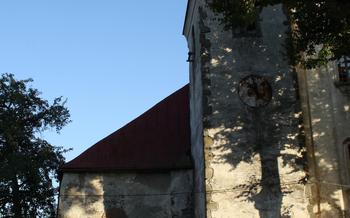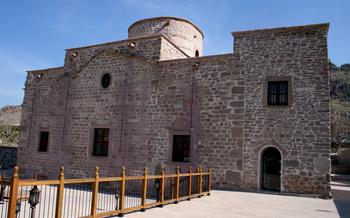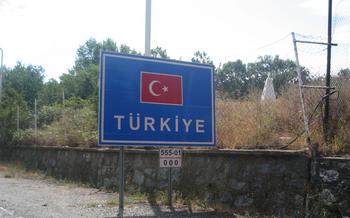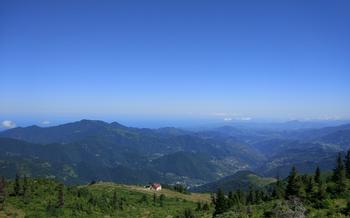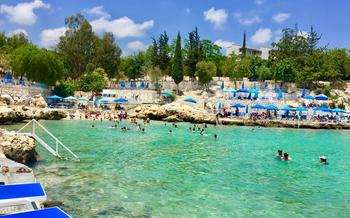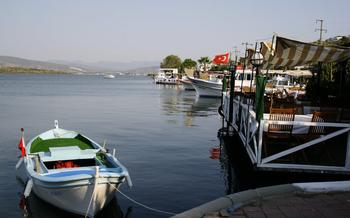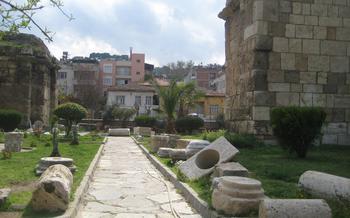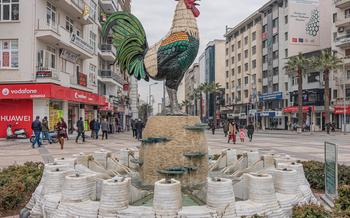
Af Kule Monastery
- Af Kule Monastery: A Symbol of Byzantine Heritage
- History: Unraveling the Past
- Architecture: A Blend of Byzantine and Ottoman Styles
- Frescoes: A Journey Through Sacred Art
- Monastic Life: A Glimpse into the Past
- Pilgrimage and Worship
- Cultural Crossroads: A Tapestry of Influences
- Restoration and Preservation: Reviving a Legacy
- Challenges of Restoration
- Ongoing Restoration Projects
- Local and International Collaboration
- Preserving a Cultural Treasure
- Visiting Af Kule Monastery: A Guide for Travelers
- Exploring the Surroundings: A Nature's Wonders
- Local Cuisine: Tantalizing Flavors
- Festivals and Events: Celebrating Culture and History
- Accommodation Options: A Range of Choices
- Getting Around: Navigating the Region
- Insider Tip: Unveiling Hidden Gems
Af Kule Monastery: A Symbol of Byzantine Heritage
The Af Kule Monastery stands as a testament to the rich Byzantine heritage of Turkey. Founded in the 11th century, it was a thriving center of monasticism, drawing pilgrims from across the Byzantine Empire. The monastery's architectural features, including its impressive dome and arched ceilings, reflect the grandeur of Byzantine architecture. The monastery's most striking feature is its collection of frescoes, depicting biblical scenes and saints with exquisite detail. These frescoes offer a glimpse into the spiritual and artistic traditions of the Byzantine era. The monastery's enduring legacy as a symbol of cultural exchange and religious tolerance makes it a must-visit destination for anyone interested in the history and culture of Turkey.
History: Unraveling the Past
The Af Kule Monastery's history is a captivating tale that spans centuries, beginning with its establishment during the Byzantine era when it served as a prominent center of monasticism. During this period, the monastery flourished, becoming a sanctuary for monks seeking spiritual fulfillment and a refuge for pilgrims seeking solace and guidance.
The monastery's golden age continued under Byzantine rule, as it received imperial patronage and grew in influence. It became a renowned center of learning and spirituality, attracting scholars, theologians, and pilgrims from across the region. The monks devoted their lives to prayer, study, and contemplation, contributing to the intellectual and spiritual development of the Byzantine Empire.
However, the monastery's fortunes changed dramatically after the Ottoman conquest of the region in the 15th century. The Ottomans, while tolerant of other religions, did not actively support the monastery, leading to its gradual decline and eventual abandonment. Over time, the monastery fell into disrepair, its once-vibrant frescoes fading and its structures succumbing to the ravages of time and neglect.
Despite its abandonment, the Af Kule Monastery remained a symbol of Byzantine heritage and a testament to the region's rich cultural and religious history. In recent years, there have been significant efforts to restore and preserve this valuable heritage site, ensuring that its legacy continues to inspire and captivate future generations.
Architecture: A Blend of Byzantine and Ottoman Styles
The Af Kule Monastery stands as a testament to the architectural prowess of the Byzantine era, showcasing a harmonious blend of Byzantine and Ottoman influences. Its layout is characterized by a central courtyard surrounded by various structures, including the church, refectory, and living quarters for the monks. The monastery's defensive fortifications, evident in its sturdy walls and strategically placed towers, reflect the turbulent times in which it was built.
The construction of the monastery primarily utilized stone and brick, materials that have withstood the test of time, ensuring its longevity. The monastery's striking dome, a symbol of Byzantine architecture, dominates the skyline and serves as a beacon for pilgrims and visitors. Arched ceilings throughout the complex add an air of grandeur and elegance to the monastery's interior spaces.
One of the most captivating features of the Af Kule Monastery is its collection of frescoes, which adorn the walls and ceilings with intricate and vibrant imagery. These frescoes, created using traditional Byzantine techniques, depict biblical scenes, saints, and historical figures, bringing to life the stories and beliefs of the monastery's inhabitants. The symbolism embedded within these artworks provides a glimpse into the spiritual and cultural world of the Byzantine era.
Frescoes: A Journey Through Sacred Art
The Af Kule Monastery is adorned with a collection of stunning frescoes that are a testament to the artistic and religious significance of the site. These frescoes, created using the fresco technique, involve painting on wet plaster, resulting in vibrant and long-lasting artworks.
The frescoes depict a variety of subjects, including biblical scenes, saints, and historical figures, each with its own unique symbolism and deeper meaning. The Annunciation, featuring the angel Gabriel appearing to the Virgin Mary, is one of the most prominent frescoes, showcasing the monastery's devotion to the Virgin Mary.
The frescoes also serve as a window into the monastic life of the past, illustrating the daily routines and spiritual practices of the monks who resided here. Scenes depicting monks engaged in prayer, reading, and other religious activities provide a glimpse into the spiritual atmosphere that permeated the monastery.
The artistic style of the frescoes is characterized by its Byzantine influences, with elongated figures, rich colors, and a focus on capturing the emotional and spiritual essence of the subjects. The frescoes, with their intricate details and expressive faces, offer a unique insight into the artistic traditions that flourished during the Byzantine period.
Overall, the frescoes of the Af Kule Monastery are a remarkable artistic and religious treasure that contributes to the monastery's status as a significant cultural and historical site.
Monastic Life: A Glimpse into the Past
The Af Kule Monastery was not just a place of worship but also a center of learning and community. The monks who lived here followed a strict routine of prayer, work, and study. They rose before dawn for morning prayers and spent the day working in the fields, tending to the animals, and studying religious texts. The monastery also served as a hospital and a school for the local community. The monks provided medical care to the sick and taught the children of the surrounding villages. They also offered spiritual guidance and counseling to those in need.
The monastic community was largely self-sufficient. They grew their own food, raised their own animals, and produced their own clothing. They also had a number of workshops where they made everything from furniture to pottery. The monks were skilled craftsmen and their work was highly prized by the local community. The monastery was an important economic center and its activities helped to support the surrounding region.
The monks of the Af Kule Monastery played an important role in preserving and transmitting the Byzantine cultural heritage. They copied and illuminated manuscripts, and they taught the Greek language and literature to the local population. The monastery was also a center of artistic activity. The monks produced beautiful icons, frescoes, and mosaics that adorned the monastery's walls and ceilings. These works of art are still admired today for their beauty and craftsmanship.
Pilgrimage and Worship
The Af Kule Monastery holds immense significance as a pilgrimage site for Christians, drawing visitors from across the region and beyond. Throughout history, pilgrims have flocked to the monastery to seek spiritual renewal, pay homage to the saints, and witness the sacred relics housed within its walls.
Among the most important religious rituals and ceremonies that took place in the monastery were the divine liturgies and prayers conducted by the monks. These ceremonies were often accompanied by beautiful Byzantine hymns and incense, creating an atmosphere of devotion and spirituality.
Beyond its role as a center of worship, the Af Kule Monastery also played a crucial role in promoting religious tolerance and understanding. It served as a meeting point for Christians of different denominations, fostering dialogue and mutual respect. The monastery's commitment to interfaith harmony earned it a reputation as a symbol of peaceful coexistence and religious pluralism.
To this day, the Af Kule Monastery continues to be a place of pilgrimage and spiritual retreat. Visitors come to seek solace, offer prayers, and connect with their faith. The monastery's enduring significance as a religious site speaks to its enduring legacy as a center of spirituality and devotion.
Cultural Crossroads: A Tapestry of Influences
The Af Kule Monastery stands as a testament to the rich cultural tapestry of the region, where Byzantine, Ottoman, and Greek Orthodox traditions intertwined and left their distinct marks. The monastery's architecture, frescoes, and rituals reflect the cultural exchange and synthesis that occurred over centuries. Byzantine influences are evident in the monastery's layout, domes, and arched ceilings, while Ottoman elements can be seen in the use of stone and brick in its construction. The monastery's frescoes, with their beautiful depictions of biblical scenes and saints, exemplify the artistic fusion of Byzantine and Greek Orthodox styles.
As a cultural crossroads, the monastery played a vital role in preserving and transmitting cultural heritage. It was a center of learning and scholarship, where monks meticulously copied and preserved ancient manuscripts, passing on knowledge and traditions to future generations. The monastery also served as a refuge for scholars and artists fleeing religious persecution, fostering a vibrant intellectual and artistic community. Its cultural influence extended beyond its walls, as the monks interacted with the surrounding Christian and Muslim communities, sharing ideas, customs, and traditions.
Restoration and Preservation: Reviving a Legacy
The Af Kule Monastery, with its rich history and cultural significance, stands as a testament to the enduring power of faith and human artistry. However, the relentless passage of time and the ravages of nature have taken their toll on this architectural masterpiece. Recognizing the urgency to preserve this invaluable heritage for future generations, extensive restoration and preservation efforts are underway.
Challenges of Restoration
Restoring the Af Kule Monastery to its former glory presents a unique set of challenges. The monastery's remote location, coupled with its age and fragile condition, makes the task even more daunting. The restoration team faces the delicate task of balancing the need for preservation with the desire to maintain the monastery's authenticity.
Ongoing Restoration Projects
Despite the challenges, significant progress has been made in restoring the monastery. The restoration projects focus on stabilizing the monastery's structures, repairing damaged frescoes, and conserving the monastery's architectural features. The use of traditional techniques and materials ensures that the monastery's original character is preserved.
Local and International Collaboration
The restoration efforts at the Af Kule Monastery are a testament to the power of collaboration between local communities and international organizations. The Turkish government, in partnership with UNESCO and other international bodies, plays a crucial role in providing funding, expertise, and technical assistance for the restoration projects.
Preserving a Cultural Treasure
The restoration of the Af Kule Monastery is not merely a physical undertaking; it is a symbolic act of preserving a cultural treasure that transcends national and religious boundaries. The monastery stands as a reminder of the rich tapestry of civilizations that have shaped the history of Turkey, and its restoration ensures that its legacy will continue to inspire generations to come.
Visiting Af Kule Monastery: A Guide for Travelers
Nestled amidst the serene landscapes of Muğla, the Af Kule Monastery is a treasure waiting to be explored. To fully immerse yourself in the monastery's rich history and breathtaking beauty, planning your visit is essential.
Location and Accessibility:
The Af Kule Monastery is conveniently located near the town of Milas in Muğla province. To reach the monastery, you can take a local bus or rent a car for a scenic drive through the picturesque Turkish countryside.
Recommended Time to Visit:
The best time to visit the Af Kule Monastery is during the shoulder seasons, spring (April-May) and autumn (October-November), when the weather is pleasant, and the crowds are smaller. During the summer months (June-August), temperatures can soar, and the monastery can be quite crowded with tourists.
Essential Items and Tips:
Remember to bring comfortable walking shoes, as you'll be exploring uneven terrain and climbing stairs. Dress modestly and respectfully, as the monastery is an active religious site. Don't forget your camera to capture the monastery's stunning architecture and frescoes. Stay hydrated by bringing a water bottle, especially during hot weather. Be mindful of the monastery's tranquility and maintain a respectful tone when speaking.
Dress Code and Appropriate Behavior:
When visiting the Af Kule Monastery, it's important to dress modestly and respectfully, as it is an active religious site. Avoid wearing shorts, tank tops, or revealing clothing. Men should remove their hats when entering the monastery church. Additionally, remember to be respectful of the monks and other visitors by maintaining a quiet and reverent atmosphere.
Exploring the Surroundings: A Nature's Wonders
The Af Kule Monastery is nestled amidst breathtaking natural scenery, inviting visitors to explore its surroundings and immerse themselves in the beauty of nature. The monastery's location offers easy access to hiking trails that wind through lush forests, leading to panoramic viewpoints that offer stunning vistas of the surrounding landscapes. Capture the monastery's grandeur from a different perspective as you embark on these scenic trails, framed against the backdrop of the picturesque Turkish hills. Don't forget your camera to capture the monastery's architectural beauty from unique angles, surrounded by nature's tapestry.
In the vicinity of the monastery, discover charming villages that offer a glimpse into the local way of life and vibrant culture. Stroll through cobbled streets lined with traditional houses, visit local markets where artisans showcase their handmade crafts, and savor authentic Turkish cuisine in family-run restaurants that exude warmth and hospitality. These villages are a treasure trove of cultural experiences, allowing you to connect with the local community and gain insights into their customs and traditions.
Local Cuisine: Tantalizing Flavors
In the heart of Muğla, tantalizing aromas waft through the air, inviting you to savor the region's delectable cuisine. From traditional Turkish dishes to local specialties, Muğla's culinary scene is a symphony of flavors that will delight your palate.
At the foot of the Af Kule Monastery, nestled amidst picturesque alleys, you'll find an array of authentic restaurants and cafes waiting to tempt your taste buds. Begin your culinary journey with a traditional Turkish breakfast, where fresh bread, creamy cheeses, olives, and sweet jams dance harmoniously on your plate.
For lunch, indulge in a hearty pide, a Turkish flatbread topped with succulent lamb or aromatic vegetables, baked to perfection in a stone oven. Alternatively, savor the flavors of güveç, a slow-cooked stew of tender meat, vegetables, and spices, served in a clay pot that retains the dish's warmth and richness.
As the sun sets, embark on a meze crawl, sampling an array of small plates that showcase the region's culinary prowess. Delight in the tangy freshness of cacık, a yogurt-based dip with cucumber and garlic, or savor the smoky flavors of grilled eggplant and peppers. Accompany these delights with a glass of local wine, produced from grapes grown in the fertile valleys of Muğla.
Don't miss the opportunity to try keşkek, a traditional dish made from pounded wheat, meat, and spices, often served during special occasions. Its rich, hearty flavor is a testament to the region's culinary heritage.
Remember to support local businesses by dining at family-run restaurants and cafes. These establishments not only offer delicious food but also provide a glimpse into the warm hospitality of the Muğla people.
So, as you explore the wonders of the Af Kule Monastery, take time to savor the culinary delights of Muğla. Each bite is a celebration of the region's rich history, vibrant culture, and passionate love for food.
Festivals and Events: Celebrating Culture and History
The Muğla region is renowned for its vibrant festivals and events that showcase the area's rich cultural heritage. These celebrations provide an excellent opportunity for visitors to immerse themselves in local traditions and customs.
One of the most popular events is the Muğla Culture and Art Festival, held annually in July. This festival features a variety of traditional music and dance performances, art exhibitions, and craft demonstrations. Visitors can also sample local cuisine and purchase handmade souvenirs.
Another highlight is the Bodrum International Dance Festival, held in August. This festival brings together dancers from all over the world to perform in a variety of styles, including ballet, contemporary, and folk dance.
For those interested in history, the Milas Carpet Festival, held in September, is a must-see. This festival celebrates the region's long tradition of carpet weaving and features exhibitions of beautiful handmade carpets, as well as demonstrations by skilled weavers.
By visiting the Af Kule Monastery during one of these festivals, travelers can gain a deeper understanding of the region's rich cultural heritage and experience the warm hospitality of the local people.
Accommodation Options: A Range of Choices
When planning your visit to the Af Kule Monastery, you'll find a variety of accommodation options to suit different preferences and budgets. From budget-friendly hostels to luxurious resorts, there's something for every traveler. If you're seeking a more immersive experience, consider staying in one of the charming guesthouses or bed and breakfasts in the nearby villages. These accommodations often offer a taste of local life and cuisine, allowing you to connect with the community and learn about their traditions.
To ensure a comfortable and hassle-free stay, it's advisable to book your accommodation in advance, especially during the peak tourist season. This will guarantee your preferred choice and avoid any last-minute surprises. Whether you're looking for a budget-friendly option or a luxurious retreat, you'll find suitable accommodations that will complement your visit to the Af Kule Monastery and enhance your overall experience.
Getting Around: Navigating the Region
Getting to the Af Kule Monastery is relatively easy, with several transportation options available. Public transportation is a convenient and affordable choice. Buses run regularly from Muğla and other nearby towns. The bus stop is located just a short walk from the monastery. Renting a car offers more flexibility and allows you to explore the region at your own pace. Several car rental agencies are located in Muğla. The roads are well-maintained, and parking is available near the monastery. Guided tours and excursions are another option for those who prefer a more organized experience. These tours typically depart from nearby cities and include transportation, a guided tour of the monastery, and other attractions in the area.
Insider Tip: Unveiling Hidden Gems
Beyond the well-known attractions of the Af Kule Monastery, there are hidden gems waiting to be discovered by curious travelers. One insider tip is to seek out a secluded spot within the monastery grounds that offers breathtaking panoramic views of the surrounding landscape. This secret viewpoint is known only to a few locals and provides a unique perspective on the monastery's grandeur and its harmonious integration with the natural environment.
Another hidden gem is a nearby village that has managed to preserve its traditional way of life and culinary heritage. This charming village is a haven for food enthusiasts, offering authentic dishes prepared using fresh, local ingredients. Visitors can savor the flavors of traditional Turkish cuisine and interact with the friendly villagers, who are eager to share their stories and cultural traditions.
For nature lovers, there is a lesser-known hiking trail that leads to a hidden waterfall nestled amidst lush greenery. This tranquil spot is perfect for escaping the crowds and enjoying the serenity of nature. The trail itself offers stunning views of the surrounding mountains and valleys, making it a rewarding experience for hikers of all levels.
Finally, for those interested in experiencing local customs and traditions, there is an annual festival that celebrates the region's unique cultural heritage. This vibrant festival showcases traditional music, dance, and handicrafts, providing visitors with an immersive experience of the region's rich cultural tapestry. Attending this festival is a fantastic opportunity to connect with the local community and gain insights into their way of life.
